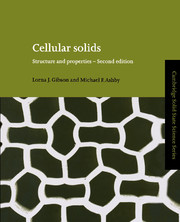Book contents
- Frontmatter
- Contents
- Preface to the second edition
- Preface to the first edition
- Units and conversion tables
- Chapter 1 Introduction
- Chapter 2 The structure of cellular solids
- Chapter 3 Material properties
- Chapter 4 The mechanics of honeycombs
- Chapter 5 The mechanics of foams: basic results
- Chapter 6 The mechanics of foams: refinements
- Chapter 7 Thermal, electrical and acoustic properties of foams
- Chapter 8 Energy absorption in cellular materials
- Chapter 9 The design of sandwich panels with foam cores
- Chapter 10 Wood
- Chapter 11 Cancellous bone
- Chapter 12 Cork
- Chapter 13 Sources, suppliers and property data
- Appendix: The linear-elasticity of anisotropic cellular solids
- Index
- References
Chapter 9 - The design of sandwich panels with foam cores
Published online by Cambridge University Press: 05 August 2014
- Frontmatter
- Contents
- Preface to the second edition
- Preface to the first edition
- Units and conversion tables
- Chapter 1 Introduction
- Chapter 2 The structure of cellular solids
- Chapter 3 Material properties
- Chapter 4 The mechanics of honeycombs
- Chapter 5 The mechanics of foams: basic results
- Chapter 6 The mechanics of foams: refinements
- Chapter 7 Thermal, electrical and acoustic properties of foams
- Chapter 8 Energy absorption in cellular materials
- Chapter 9 The design of sandwich panels with foam cores
- Chapter 10 Wood
- Chapter 11 Cancellous bone
- Chapter 12 Cork
- Chapter 13 Sources, suppliers and property data
- Appendix: The linear-elasticity of anisotropic cellular solids
- Index
- References
Summary
Introduction and synopsis
Structural members made up of two stiff, strong skins separated by a lightweight core are known as sandwich panels. The separation of the skins by the core increases the moment of inertia of the panel with little increase in weight, producing an efficient structure for resisting bending and buckling loads. Because of this, sandwich panels are often used in applications where weight-saving is critical: in aircraft, in portable structures, and in sports equipment. Figure 9.1 shows the rotor blade from a helicopter and a flooring panel from a Boeing 747; Fig. 9.2 shows a prefabricated housing wall panel; and Fig. 9.3 shows sections from a downhill ski and from the hull of a racing yacht. In these examples, the skins or face materials are, typically, aluminium or fibre-reinforced composites; the cores are aluminium or paper-resin honeycombs, polymeric foams or balsa wood, all of which have a cellular structure.
Nature, too, makes use of sandwich designs. Sections through the skull of a human and the wing of a bird both clearly show a low-density core separating the solid faces (Fig. 9.4). Plants, too, can have a sandwich structure: that of the iris leaf, described in more detail below, is shown in Fig. 9.22(b) while that of a stalk was shown earlier, in Fig. 2.6(h). In all of these examples, the faces and core are made from the same material with the faces almost fully dense and the core a foam.
The mechanical behaviour of a sandwich panel depends on the properties of the face and core materials and on its geometry.
- Type
- Chapter
- Information
- Cellular SolidsStructure and Properties, pp. 345 - 386Publisher: Cambridge University PressPrint publication year: 1997
References
- 6
- Cited by



